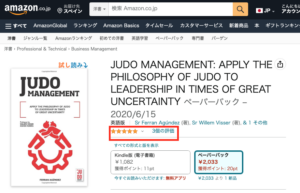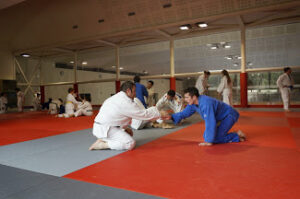This article about Judo and more special about randori and kata of Willem Visser, 8th Dan Judo IJF, executive coach, strategic adviser, and international lecturer , is the first publishing of a series that will appear in the magazine periodically. We are very proud to count with his knowledge and experience as a new member of the Advisory Council of Judo management.
Judo is a game, a sport, a system of physical education, a system for physical and mental development, a system of self-defence, a cultural-movement activity, a philosophy, an attitude, a way of life. The sequence of this enumeration depends other things, on the age, the quality, the interest, the stage of development and the stage of life of the judoka. Of course more circumstances, personal values and competences added to this list, which I leave to the reader of this article.
In this article I will not go into the history of judo, because Professor Murata, Dr Brousse, Dr Cadot and Professor de Cree can do that in a, to be organized, seminar about the history of judo. This article can be a contribute to the understanding, by means of exchange of views on the importance of randori and kata.
KATA
In an earlier published article about Kodokan Judo I mentioned the overload of interest for kata. The excessive interest in kata threatens to overshadow the most beautiful phenomenon in judo: randori.
It is good to know, that judo can exist without kata; judo cannot exist without randori.
And to avoid being seen as a ‘kata opponent’ I will first specify a number of values of kata.
In many scientific articles definitions of game and sport are given (further on in this article I will mention some definitions) and based on these definitions it is possible to interpret randori and shiai (contest); to interpret kata based on definitions of game and sport is difficult.
However, in a scientific published research of the University of Hamburg in Germany, Dr Horst Tiwald, distinguish three forms of human movement.
a. Simple result oriented moving; in this form of movement motor skills are relatively simple, both technically and conditionally (walking, running, swimming etc.) Improving perception, analysing and situational action is certainly not of the greatest importance.
b. Attrition oriented moving; technical skills are much more important than in simple result oriented moving; physical condition is additional. (Gymnastics, figure skating). As in simple result oriented moving improving perception, analysis and situational action is also not of greatest importance. There are no unexpected fast changing situations and limitations are not imposed by others.
c. Complex result oriented moving; in this form of movement is technique, physical condition, observation, quick analysis, decision and implementation of the technique and respond quickly and adequately to constantly, often unforeseen and changing situations (often limited by opponent, time and space), characteristic. (Game sport and martial arts; in martial arts, as judo, time and space are the most limited.)
(Sportwissenschaft und Sportpraxis, Band 38, Psycho-Training im Kampf- und Budo-Sport, Horst Tiwald. ISSN 0342-457X)
Kata can be placed in b. attrition oriented moving.
One of the characteristics of kata is, that the techniques to be executed must be the basic form of indisputable (fixed) movements. In a certain sense the base of kata is a ‘theoretical specification’ of attack and defence. Ethics, aesthetics, mechanics and logic are parts of kata, as well as in randori and shiai (complex result oriented moving).
Kata is not a demonstration of separate techniques (and it may not be); kata is an art form with an ‘own view’. With ‘own view’ is meant, that kata is performed by tori and uke. Tori and uke, who must be of equal level in terms of technique and attitude in which harmony and rhythm are important. There must be harmony in one’s own rhythm and the rhythms of tori and uke must be aligned. That harmony in one’s own rhythm and the coherence in rhythms of tori and uke form the ‘own view’. The basic form of indisputable (fixed) movements cannot be affected, because the definitions of ethics, aesthetics, mechanics and logic have not changed.
Harmony does not mean angular, it is easy, elegant and fluently; for kata this means that ‘angular and fierce actions’ must be avoided, as this leads to energy disputes, energy loss (against the principles of judo). Rhythm is the harmonious change of tension and relaxation.
Breathing affects the rhythm, the breathing regulates the rhythm; those who control their breath: control their movements, their balance, their posture and their mental attitude.
In kata, just as in the complete phenomenon Judo:
“ everything must lead to, with maximum of effectiveness, to general well-being””.
Kata in judo is the harmonious and rhythmical practice and/or performance of the fixed basic forms of judo techniques by tori and uke, based on the theoretical data of attack and defense.
The different kata derive the fixed basic forms from the appearance, such as principles of throwing, controlling, defending, suppleness, balance and even principles of the cosmos.
Kata is an excellent exercise in many ways.
As an intermezzo I want to introduce an idea for the development of the judoka and perhaps it can be important for when drawing up of graduation requirements:
– In the kyu period: learning basic techniques as nage waza, ne waza and …RANDORI.
– The period of 1st dan, 2nd dan and 3rd dan is a period of developing tokui waza and…RANDORI.
– The period of 4th dan en 5th dan is the period of profundity. Background, style and ritual of, among other things, kata; also studying what, how and why.
– The period of 6th dan and higher is the period of studying the essence of judo in life and in the life of a judoka.
Judo is a phenomenon or form of physical and mental education and development, a form of posture and movement. Posture and movement mean much more than just efficiency; caring for style and respect of ritual must have a prominent place.
An appropriate statement was used by the Olympic Champion Mr. Anton Geesink:
“If you want to be a champion, you have to look like a champion!”
And many other Olympic Champions such as Ruska, Saitoh, Yamashita, Douillet, Huizinga are very good examples in in terms of this statement.
Examinations and examiners also have to be stylish and ritual must also have a place here. Style and ritual bring dignity and calmness.
If wisdom comes when it is too late, than wisdom is useless.
Willem Visser Executive coach, Strategic Adviser, International Lecturer, 8th Dan Judo IJF
With gratitude to all my teachers, specialists, colleagues and especially all the judoka that I was allowed to guide and to coach.
Sources and inspiring professionals:
Van der Horst, Cobben, Abe, Saitoh, Yamashita, Uemura, Sugawara, Murata, Hosokawa, Komata, Takahashi, Nakamura, Kasuga, Kawashima, Kariya, Brousse, Besson, Rougé, Ruska, Geesink, de Cree, Barta, Vachun, Viser, Lascau, McConnell, Snijders, Sins, Hoogendijk, Boersma, Odinot, van Dijk, Klok and many others.




